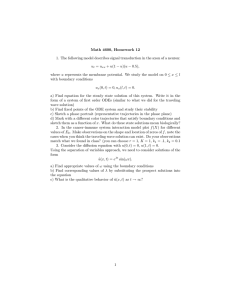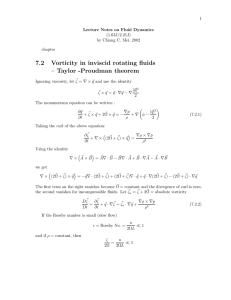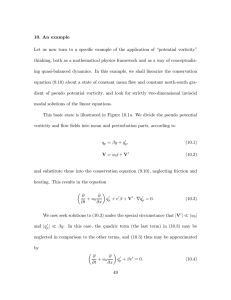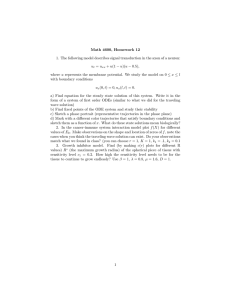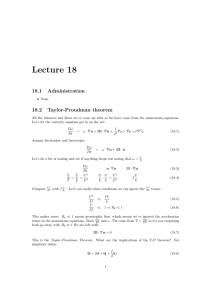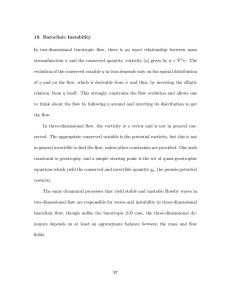12. A specific example illustrating the importance of dynamical boundary conditions... Eady a quasi-geostrophic fluid in a semi-infinite domain, as illustrated in...
advertisement
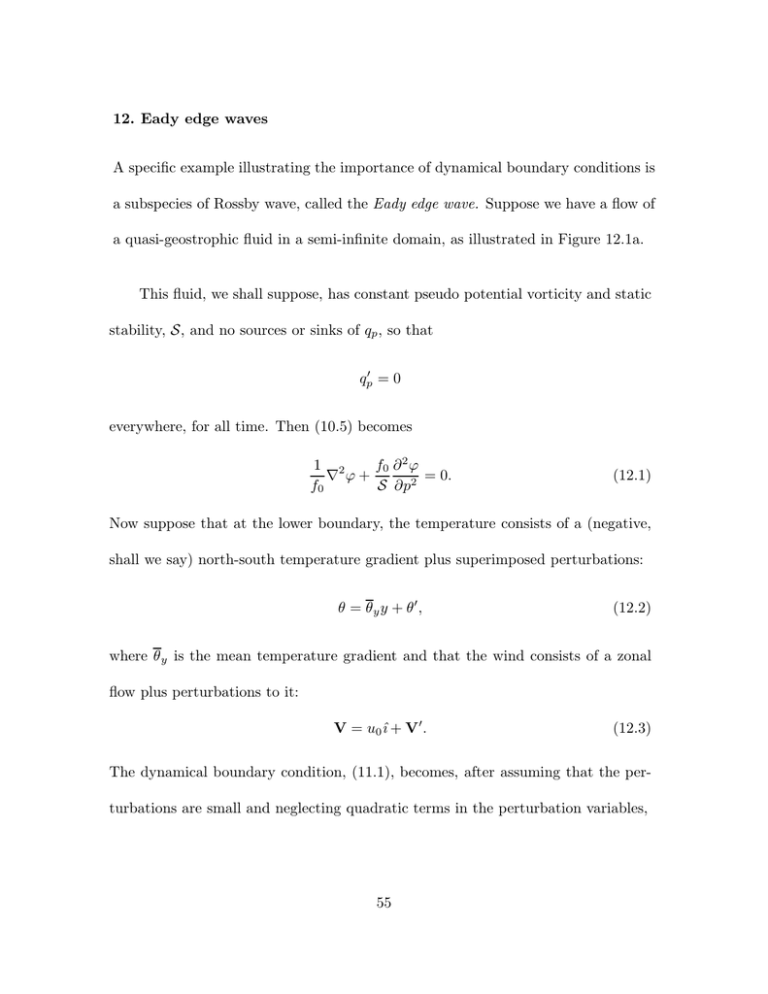
12. Eady edge waves A specific example illustrating the importance of dynamical boundary conditions is a subspecies of Rossby wave, called the Eady edge wave. Suppose we have a flow of a quasi-geostrophic fluid in a semi-infinite domain, as illustrated in Figure 12.1a. This fluid, we shall suppose, has constant pseudo potential vorticity and static stability, S, and no sources or sinks of qp , so that qp = 0 everywhere, for all time. Then (10.5) becomes f0 ∂ 2 ϕ 1 2 ∇ ϕ+ = 0. f0 S ∂p2 (12.1) Now suppose that at the lower boundary, the temperature consists of a (negative, shall we say) north-south temperature gradient plus superimposed perturbations: θ = θy y + θ , (12.2) where θ y is the mean temperature gradient and that the wind consists of a zonal flow plus perturbations to it: V = u0 ı̂ + V . (12.3) The dynamical boundary condition, (11.1), becomes, after assuming that the per­ turbations are small and neglecting quadratic terms in the perturbation variables, 55 ∂ ∂ + u0 ∂t ∂x ∂ϕ ∂ϕ +γ =0 ∂p ∂x at p = p0 , (12.4) where we have used the geostrophic wind relation (10.6), and γ ≡ −θ y R/f0 p0 , (12.5) using (8.33). (Had we used an example from the ocean, γ would have been −Gσ y evaluated at a suitable pressure level.) For simplicity, we shall assume that the temperature perturbations vanish at the top of the fluid, so that ∂ϕ = 0 at ∂p p = 0. (12.6) Since the fluid is semi-infinite, we are entitled to look for model solutions that are periodic in x, y, and time, so let ϕ = ϕ̂(p)eik(x−ct)+ily , (12.7) where k, l, and c have the same meanings as before. Substituting (12.7) into (12.1), (12.4) and (12.6) gives d2 ϕ̂ S − 2 (k 2 + l2 )ϕ̂ = 0, 2 dp f0 (12.8) subject to the boundary conditions (u0 − c) dϕ̂ + γϕ̂ = 0 dp dϕ̂ =0 dp on p = p0 , (12.9) on p = pt . (12.10) The system comprised of (12.8)–(12.10) is a closed eigenvalue problem with the solution ϕ̂ = A cosh(rp), (12.11) where A is an arbitrary amplitude, with r2 ≡ S 2 (k + l2 ). f0 (12.12) This can only satisfy the lower boundary condition (12.9) if c = u0 + γ ctnh(rp0 ), r (12.13) with r given by (12.12). Provided γ is positive (which, form (12.5), implies a nega­ tive temperature gradient), the waves will travel eastward relative to the background flow. Note that, like Rossby waves, the relative phase speed increases without bound as the horizontal wavelength becomes large. It is also clear from (12.11) that the wave amplitude decreases more or less exponentially upward (i.e., with decreasing pressure). The wave is three-dimensional, but trapped at the lower boundary. Note that all the time dependence is in the lower boundary condition, (12.9). 57 The wave dynamics are conceptualized in Figure 12.1b. Where the isotherms are deflected northward, the temperature perturbation is positive, and vice versa; in­ vertibility sees those temperature perturbations as potential vorticity perturbations of the same sign, so that positive vorticity is associated with positive θ perturba­ tions. The associated geostrophic flow, illustrated in Figure 12.1b, is in quadrature with θ in such a way that the wave propagates eastward relative to any background flow. Remember that there are no qp perturbations in the interior of the fluid in the example, and that the boundary temperature anomalies act like delta function qp anomalies, so the wave is evanescent with height away from the boundary. That is why the wave is called an edge wave. 58 MIT OpenCourseWare http://ocw.mit.edu 12.803 Quasi-Balanced Circulations in Oceans and Atmospheres Fall 2009 For information about citing these materials or our Terms of Use, visit: http://ocw.mit.edu/terms.
